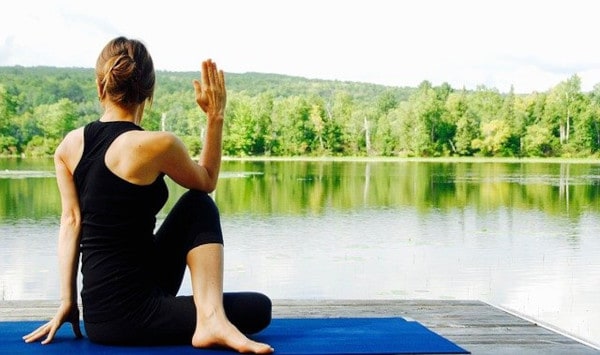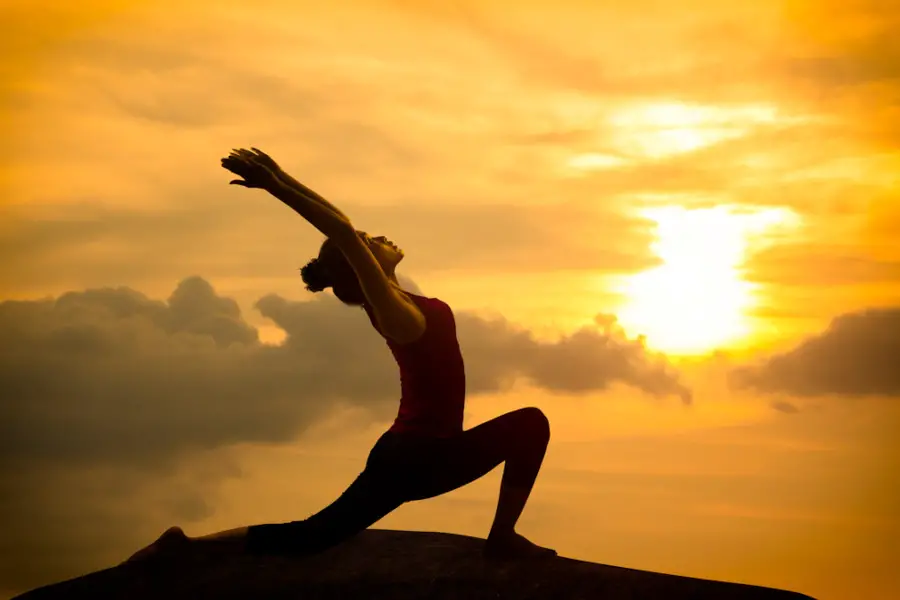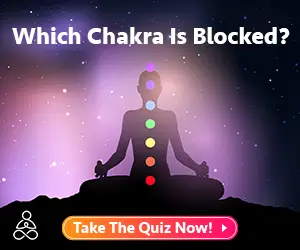Yoga meditation is simply a type of process that is produced from a successful inward turning of the mind and the acceptance of the fact that there exists a form of truth that can be considered to be higher and more satisfying compared to all of the things that the human intelligence and mind can achieve.
In most cases, people would only start to practice yoga meditation once they have reached a dead-end in their pursuit of happiness in life and solutions in the sensual and mental realm. Meditation is not excluded from life, and one shouldn’t expect to achieve results instantaneously from the moment they started to meditate.
It is a form of a culmination of sattvic and purified life. One of the best things to do is to release all of your expectations to allow yourself to be steady and open throughout the entire meditation practice. Any attempts to calm down one’s mind and withdraw the human senses would usually lead to meditation.
Some of the stabilized meditative postures and breathing methods that are recommended by most yoga instructors significantly help to calm down one’s mind. Yoga meditation would require a high level of concentration and prana (a type of essential energy that is said to be everywhere in the universe). Regulating our daily lifestyle is known to be effective in conserving prana to be used for inner discoveries and realization.
A sick individual with a low level of prana is known to have more challenges and difficulties in accumulating the rays of the mind and prana that can be used for meditations. It’s highly recommended for you to rest yourself in prayers instead if you happen to be sick at that point in time. Constant practice of Japa and continuous repetition of mantras (a type of sacred utterance) are required to keep the mind ready for meditations.

Types of Yoga Meditation
Chakra Meditation
There are a lot of types of yoga meditation that are available nowadays, each with different styles. One of the most popular types of yoga meditation is Chakra meditation. Chakra Meditation, as the name, suggests works with the chakras of one’s body. Chakras can be visualized as the internal circular energy vortex that every human has in their body.
There are countless chakras in the human body; however, the most popular chakras that are known today consist of eight chakras. Every one of these chakras has its own unique color and properties. This form of meditation is usually guided, and it can be done by concentrating the mind in all of this energy vortex.
Mantra Meditation
The constant utterance of sacred words to produce sounds has always been one of the most powerful methods to sharpen the mind to keep its focus. Mantra meditation is extremely effective and powerful due to the effects made by the vibrations of the sound. Sound is known to be produced when there is a vibration that hits the eardrum, which will then be sent to the brain.
This explains how we know that sound is a type of vibration. Certain vibrations are known to have the ability to stimulate the endocrine system or, more specifically, the pineal gland and the pituitary gland that can be found in the head. By uttering the mantras repetitively, you’re keeping your mind busy while you’re breathing in a certain pattern.

Kabbalah Meditation
This type of meditation was introduced by the Jewish spiritual leaders to the entire world. These teachers tend to believe that meditation will strengthen the connection between humans and God. One of the methods that are most commonly used in this meditation is by imagining the name of God in one’s mind.
Deep within the Kabbalah meditation, there are also other minor types of meditations. Those that are still new to the world of Kabbalah meditation may begin their journey with the Shema meditation. In the Hebrew language, Shema means to hear or listen. This meditation is usually done by inhaling and exhaling the surrounding air and ending the process with the sound “shh.”
Related reading: Guide to Different Types of Meditation Practices – Opens in new tab
Yoga Poses for Meditation
Lotus Pose
The lotus pose is the ultimate posture for meditation as it has been known to assist you in sitting for an extended period of time. This pose is revered due to its soothing nature, and many referred to it as the cure for every disease. According to some ancient texts, it has been known that the Lotus pose also helps to activate the Kundalini Energy hidden inside the human body.
In terms of anatomy, this pose helps to increase the level of blood supply to the pelvis, which results in physical relief, especially from menstrual pain. Apart from that, the Lotus pose also stretches the hips, knees, and thighs while at the same time strengthening the spine.
The first step to sitting in this pose is by sitting on the floor with your legs outstretched. Then, bend your knees and interweave your legs with both of your feet placed on the opposite thighs. Finally, place both of your hands on your knees and remain in this position for as long as you can.
Quarter Lotus Pose
This is a variation of the lotus pose where instead of putting your feet at the opposite thighs, you put them at the opposite calves of your legs. This pose is one of the most revered poses that may be used for mantra chanting or meditations. It’s highly recommended for new yoga meditators or any individuals with tight ankles and hips that find sitting in a lotus pose for an extended duration to be strenuous.
The first step to sitting in this pose is by sitting on a yoga mat in an upright position. Make sure to relax your body and use your hands to cross your legs. Then, place the left foot on the calf of the right leg and vice versa. Fold your hands to make sure that both of them are joined together by the sternum (also known as the Anjali Mudra hand gesture) and place it in front of your heart.
Related reading: How to Find a Comfortable Meditation Position – Opens in new tab.
Yoga Meditation Benefits
Lowers the Level of Stress
Yoga has been known to lower the level of stress and increase the relaxation level of the human body. As a matter of fact, recent studies have also shown that yoga practice can help to minimize the secretion of cortisol which is the one that’s mainly responsible for the stress hormones in our body. A study was conducted where women that perceived themselves as emotionally stressed were gathered together to undergo three months of yoga sessions. The results show that all of the participants had a significant drop in the level of cortisol, depression, stress, and fatigue.
Minimizes Anxiety Level
Recently, more and more people have begun to practice yoga as a means to reduce their level of anxiety. One of the interesting things about this is that the latest research has shown that yoga can have a positive impact on anxiety. There is one particular study where 34 women that are diagnosed with an anxiety disorder are instructed to take part in yoga sessions twice a week for the following two months. The end results proved that the women that chose to participate in the sessions had a significant drop in anxiety levels.
Great for Cardiovascular Health
Yoga practices are also known to be beneficial for the health of your heart. Recent studies have shown that yoga practice may help to reduce the risks of having cardiovascular diseases by improving the general health of your heart. Data provided from the statistics shows that yoga practitioners aged more than 40 years old who had been actively involved in yoga meditation for five years had significantly lower blood pressure compared to those that don’t practice yoga at all.
Related reading: 8 Health Benefits of Meditation – What the Newest Research Shows
How to Begin Yoga Meditation
Start By Accepting Yourself
Yoga is not merely an exercise for your body; it’s a unique form of way to exist in the universe. You may start by eradicating any kind of wishful thinking about how things could be better for yourself. Instead, try to accept the reality of the things that you have right now to learn to appreciate all of the things that you are blessed with so that you could be more grateful.
Let Go of Your Expectations
Once you have learned the importance of gratitude, you will soon realize that you’re no longer tied to the same expectations in your life. Expectations like “she can do it on Instagram so easily, why can’t I do it?” or “I need to buy myself that leather handbag; otherwise my life is ruined..” can be avoided if you start to let it go by simply being thankful. You should try to focus your mind on the things that you’re doing right now at this moment, not the extra garbage that will soon fade away in your life.
Understanding Yoga Itself
Yoga is not about being able to contort your spine and muscles into some fancy shapes; rather, it’s about searching for your inner strength by meditating and breathing calmly. It’s all about having your own freedom in your body by utilizing the basic yoga poses that have been explained previously in the article. Hence, try not to worry about losing weight or bending your body too much. Instead, you should try to understand that yoga is a lifestyle and process that requires time and dedication.
Do you want to learn more about Meditation? Check out our recommendations at “Meditation Bookshelf” and many free resources at our “Free MeditationLibrary“ – Opens in new tab
Stay in Touch
 Join our newsletter by using the forms on this website or click here!
Join our newsletter by using the forms on this website or click here! Follow us on Google News
Follow us on Google News Follow us on Facebook
Follow us on Facebook
Featured image from Depositphotos







